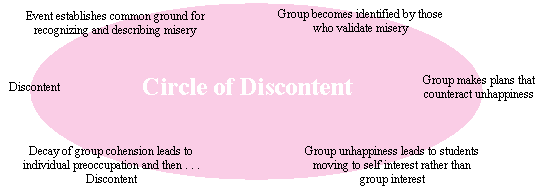ESE380 : The Class : Commander Troy : Pat : Knowledge |
||||||
Knowledge
Groups not only go through stages, there are times when they function very well, and other times when issues or individual needs interrupt the competence of the group. The following chart suggests ways to examine team concerns and move the group past snags.
| Critical questions | Indicator of problems | ||
| P | Productivity | Is the group doing enough? Are these goals or objectives |
Frustration Concern over deadlines One person doing it all |
| E | Empathy | Do members feel comfortable with each other? | Tenseness in meetings Frustration expressed Gossiping, undercurrent |
| R | Roles/goals | Do members know what is expected? | Confusion about priorities Arguments over ideas Leadership issues |
| F | Flexibity | Are members open to outside suggestions, contributions? | Fault finding with rest of class "We-they" statements Dyads flourish or "odd man" |
| O | Openness | Do people say what they think? Can members express needs? |
Lack of debate Air is "thick" |
| R | Recognition | Do members praise each other? Are achievements appreciated? |
Backbiting Sarcasm Competitive sense |
| M | Morale | People like coming to meetings Tardiness is minimal |
Members come on time Members meet outside of class |
Is Your Group Involvled in the Circle of Discontent?

Directions: Discuss each area. If issues emerge, develop a goal to address concerns
| P | Productivity
Goal |
Issues | |
| E | Empathy
Goal |
Issues | |
| R | Roles/goals
Goal |
Issues | |
| F | Flexibity
Goal |
Issues | |
| O | Openness
Goal |
Issues | |
| R | Recognition
Goal |
Issues | |
| M | Morale
Goal |
Issues | |
Vision
|
Working Group or Team?
|
Once you have finished you should:
Go back to Lesson 2
E-mail J'Anne Ellsworth at Janne.Ellsworth@nau.edu
Copyright © 2000
Northern Arizona University
ALL RIGHTS RESERVED